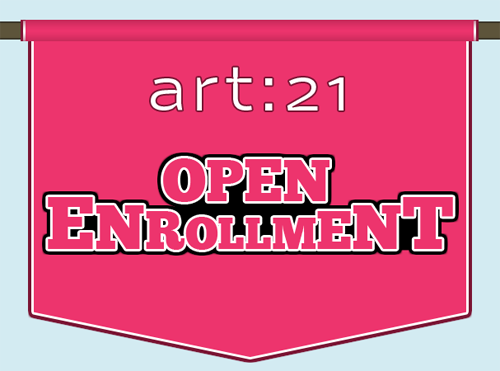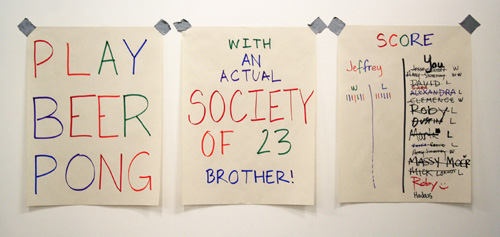With my first year at San Francisco Art Institute done and done, I’m reminded of the big and scary (but fun!) questions I had one year ago. Last August, a few weeks before school started, I met up with my second-year classmate Donald Daedalus. He had organized a group show for our New Genres department that consisted of projects created by pairs of second-years and first-years. It was a fantastic way to kick off the school year, click with our classmates, and form some kind of department bond. Unfortunately, I was totally picked last (double last, in fact, when I found out my partner, Ian Coyle, previously selected someone else who decided to withdraw), so I had a big third-grade chip on my shoulder. Regardless, that drama is beside the point. I remember Donald and I talking about life, with my anxiety level at a high as the new MFA experience was approaching, and him asking me why I decided to go to grad school. I sipped my beer, glanced at my cell phone, and casually said, “to network, I guess.” He nodded.
I have a dictionary widget on my Mac that secondarily defines network as: a group or system of interconnected people, or, a group of people who exchange information, contacts, and experience for professional or social purposes. Networking makes me think of a cliché parent, teacher, or mentor figure egging on an impressionable student to go out there and network: “Go get ‘em son!” Or in a group of hungry twenty-somethings, there’s talk of company social hours as opportunities for networking. “Free drinks and some networking—can’t go wrong.”

Jeffrey Augustine Songco, "A Network." Courtesy the artist.
During my undergraduate years at Carnegie Mellon University, I had two networks: art school and my fraternity. My art school network was a large group of classmates and professors that has, to this day, dwindled down to two classmates (Christopher Kardambikis, William Schott) and two professors (Mary Hood, Ayanah Moor). Of course, I’m Facebook friends with everyone from the past, but there’s been a lack of information exchange since 2005, if any at all. On the other hand, my secret network of brothers from Theta Xi has stayed consistently connected because of our mass exodus from Pittsburgh to San Francisco in the last few years.
What does this brief history of my personal networking have to do with my MFA experience? My lessons learned have prepared me with networking skills for my current endeavor at SFAI. While it might be too much to ask of myself to befriend every single person at SFAI, I try to reach out to the mass as a co-chair of the Legion of Graduate Students. I also align myself closely with my peers whose work resonates with my own, especially those who are in my department.
With professors, I’ve gravitated towards teachers who engage and activate the kinds of production modes that I love. This fall, I’ll be working with Robin Balliger for the third semester in a row. I never would have guessed that an anthropologist with information about power or consumption would click so perfectly with the artwork I was interested in creating. On the studio side of things, I was lucky enough to be a teaching assistant for Allan deSouza both semesters of my first year—unprecedented! At first, I was hesitant to work with Allan because his ‘bio description’ on the school’s website was a little lame. After a few weeks, I realized that he a) is the kind of professor I’d like to be one day, and b) asks the kinds of questions about art I’d like to ask one day, too. With a sort of combination of critical theory and studio work, Renée Green is the third professor who I am thrilled to have in my network. For the past year, I’ve participated in her graduate lecture series and seminar Spheres of Interest: Experiments in Thinking & Action—it was a rare chance for me to be face-to-face with contemporary artists who, like me, don’t have all the answers, but definitely have all the right questions.
Finally, my network of classmates couldn’t have been more activated than last week, when the second-years set up for their thesis exhibition, or as Corina Reynolds wrote a couple weeks ago, a “big huge end of the year MFA group show.” Herbst Pavillion at San Francisco’s Fort Mason was sectioned off into large cubicles for each student to display his/her artwork. The installation days activated the connections between students like nothing I had seen before. Some first-years (Renée Rhodes, Cristina Victor, Daniel Samaniego, Mick Lorusso, Ross Waitman, Evan DeSpelder, Walt Ohnesorge-fick, Massimo Pacchione, Hadass Mor Gerson, Adrianne Rubenstein, David Peña Lopera, and Pete Hickok to name a few) were on hand, running around the pier helping out where help was needed. For me, I helped Christina Corfield drape same gold fabric, spackled some holes for Marta Spurgeon, rolled some sticky tack balls for Scott Polach, removed some heavy duty tarp protecting Cathy Fairbanks and Laura Boles Faw’s space, measured out spacing for Cascade Wilhelm’s photographs, and pretended to be a painting so Tyler Borenstein could test the levels of his lights. If exchanges of information within this network can include simple hugs, hellos, and high fives, then download complete: Amy Sweeney, Lindsay Jordan, Daniel Yovino, Michele Wysocki, Paulina Velazquez Solis, Brynda Glazier, Mimi Moncier, Stephanie Dodes, Jesse Eric Schmidt, and Pete Belkin.
The stories don’t stop about how important and crucial networks play in the role of art production and circulation, especially within the blogosphere: this curator and this artist were in cahoots with that dealer and that collector. The call is out there for individuals in such positions to disclose the intricate bonds that form such webs. For me, the key buzzword of the month happens to be co-authorship. Barely anything I produced in the past year wouldn’t have been possible without the co-authorship from various individuals in all the networks I mentioned in this post. Let’s raise the curtain of the spectacle and allow the audience in on the production (unless, of course, the network is meant to be a secret). Oh boy, does that mean the network can grow even more? W00t!
Jeffrey Augustine Songco just completed his first year in the New Genres MFA program at the San Francisco Art Institute. Born and raised in New Jersey, he spent his childhood dancing with the New Jersey Ballet and performing at Paper Mill Playhouse. In 2005, he received his B.F.A. in Art from Carnegie Mellon University.




